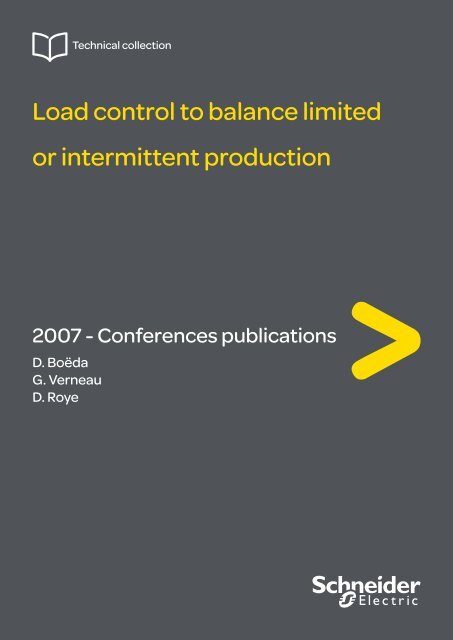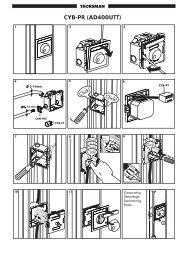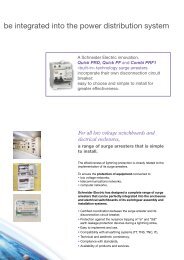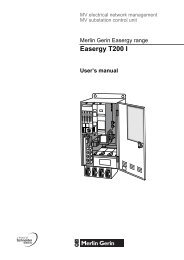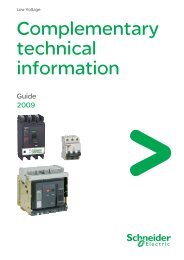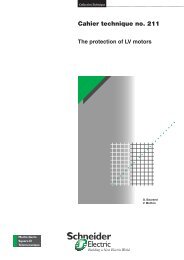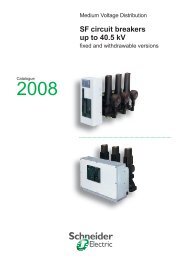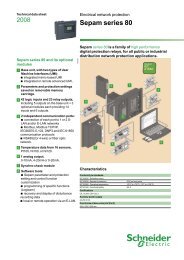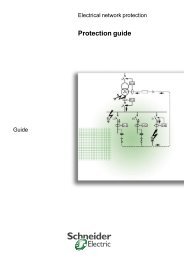Load control to balance limited or intermittent ... - Schneider Electric
Load control to balance limited or intermittent ... - Schneider Electric
Load control to balance limited or intermittent ... - Schneider Electric
You also want an ePaper? Increase the reach of your titles
YUMPU automatically turns print PDFs into web optimized ePapers that Google loves.
Technical collection<br />
<strong>Load</strong> <strong>control</strong> <strong>to</strong> <strong>balance</strong> <strong>limited</strong><br />
<strong>or</strong> <strong>intermittent</strong> production<br />
2007 - Conferences publications<br />
D. Boëda<br />
G. Verneau<br />
D. Roye
<strong>Schneider</strong> <strong>Electric</strong> 2007 - Conferences publications<br />
C I R E D <br />
<br />
<br />
<br />
LOAD CONTROL TO BALANCE LIMITED OR INTERMITTENT PRODUCTION<br />
Didier BOËDA Guillaume VERNEAU Daniel ROYE<br />
GIE-IDEA – France <strong>Schneider</strong> <strong>Electric</strong> – France LEG - France<br />
Didier.Boeda@leg.ensieg.inpg.fr guillaume.verneau@fr.schneider-electric.com Daniel.Roye@leg.ensieg.inpg.fr<br />
ABSTRACT<br />
Since the beginning of the 90’s, most European countries<br />
have seen an increasing growth of Dispersed Generation<br />
(DG) on their power systems, due <strong>to</strong> several fac<strong>to</strong>rs<br />
including government incentives, deregulation of energy<br />
market, and environmental requirements. In this context,<br />
this paper will investigate consumers’ opp<strong>or</strong>tunities <strong>to</strong> help<br />
<strong>to</strong> ensure Production/Consumption <strong>balance</strong>, by subscribing<br />
<strong>to</strong> <strong>Load</strong> Management programs. Obviously, such action will<br />
depend on the dynamics and duration of the <strong>control</strong>, but<br />
also on load characteristics. After introducing load<br />
classification, models are presented. Two kinds of adaptive<br />
load consumption alg<strong>or</strong>ithms are explained and illustrated<br />
on study cases, showing how load <strong>control</strong> can help <strong>to</strong><br />
<strong>balance</strong> <strong>intermittent</strong> production.<br />
INTRODUCTION<br />
Distribution netw<strong>or</strong>ks are nowadays currently facing new<br />
challenges with the introduction of dispersed generation<br />
(DG), and the deregulation of the electricity market. This<br />
paper investigates how load <strong>control</strong> will help <strong>to</strong> ensure<br />
Production/Consumption <strong>balance</strong> in the future through local<br />
actions, especially f<strong>or</strong> <strong>limited</strong> <strong>or</strong> <strong>intermittent</strong> production.<br />
With an increasing growth of DG on distribution netw<strong>or</strong>k,<br />
and taking in<strong>to</strong> account the decentralisation, some services<br />
will certainly appear such as local Production/Consumption<br />
<strong>balance</strong>. Obviously, this contribution will only be possible<br />
with the large scale diffusion of New Inf<strong>or</strong>mation and<br />
Communication Technologies (NICT) which are currently<br />
in expansion. Development of <strong>Load</strong> Management<br />
alg<strong>or</strong>ithms requires load classification and models; this<br />
paper will first present a classification of loads, and an<br />
inven<strong>to</strong>ry of models. Next, two kinds of alg<strong>or</strong>ithms f<strong>or</strong><br />
adaptive consumption are detailed, and illustrated on study<br />
cases.<br />
LOAD CLASSIFICATION AND MODELS<br />
<strong>Load</strong> classification<br />
A large diversity of loads is distributed on the netw<strong>or</strong>k. In<br />
<strong>or</strong>der <strong>to</strong> implement efficient load <strong>control</strong> strategies, a<br />
classification is required <strong>to</strong> determine which loads are the<br />
most appropriate f<strong>or</strong> a specific load <strong>control</strong>. This<br />
classification is multi-criteria: it depends on various<br />
parameters, such as <strong>control</strong>lability, power, use, <strong>control</strong>lable<br />
power and time margin, load type, and dynamics [1]. It also<br />
depends on the field of application (residential, commercial,<br />
industrial <strong>or</strong> agricultural), and on the scale of the pool of<br />
loads (a single house, a neighbourhood, a facility, a<br />
<strong>to</strong>wn…).<br />
<strong>Load</strong>s that cannot be <strong>control</strong>led are defined as critical, even<br />
if this term could be misunders<strong>to</strong>od. Depending on their<br />
characteristics, <strong>control</strong>lable loads can be used in different<br />
ways. Some loads are called “<strong>control</strong>lable” because they can<br />
be interrupted fully <strong>or</strong> partially f<strong>or</strong> a determined <strong>or</strong><br />
undetermined duration. Other loads are “pre” <strong>or</strong> “postshiftable”,<br />
because they can be advanced <strong>or</strong> delayed without<br />
significant drawback f<strong>or</strong> users.<br />
Simultaneously, a <strong>control</strong> level is defined f<strong>or</strong> each load,<br />
depending on these notions. Figure 1 presents an example of<br />
this classification, acc<strong>or</strong>ding <strong>to</strong> their <strong>control</strong>lability [1].<br />
Others equipments<br />
Critical<br />
Lighting loads<br />
Industrial warming<br />
and cooling equipments<br />
<strong>Electric</strong>al goods<br />
Rotating equipments<br />
Hot water heater<br />
and heat s<strong>to</strong>rage<br />
Figure 1: scale of <strong>control</strong>lable loads<br />
Thermal loads<br />
Fully <strong>control</strong>lable<br />
Thermal loads: These loads are composed of heating,<br />
ventilating and air conditioning equipment. Thermal<br />
comf<strong>or</strong>t equipment represents between 30% and 50% of<br />
energy consumption of residential and tertiary sec<strong>to</strong>r<br />
buildings [2]. The thermal inertia of these loads can be<br />
utilized in load <strong>control</strong> strategies, without degrading users’<br />
comf<strong>or</strong>t.<br />
Hot water heater and heat s<strong>to</strong>rage: <strong>Electric</strong>al hot water<br />
heaters are easily <strong>control</strong>lable. Demand Side Management<br />
(DSM) programs in the USA take benefit of these loads.<br />
Integration of NICT would enable a better tune of these<br />
loads <strong>to</strong> electricity market, and <strong>to</strong> netw<strong>or</strong>k constraints [1].<br />
Rotating equipment: These loads are composed of<br />
ventilation and pool pumps. Such a kind of load <strong>control</strong><br />
program exists in Calif<strong>or</strong>nia [3].<br />
<strong>Electric</strong>al goods: These loads are mainly composed of<br />
dryers and washers. They present the opp<strong>or</strong>tunity <strong>to</strong> be<br />
shifted. DSM programs in the USA largely use these<br />
applications so as <strong>to</strong> smooth consumption peaks. M<strong>or</strong>eover<br />
electrical goods construc<strong>to</strong>rs try <strong>to</strong> improve these<br />
equipments behaviour in <strong>or</strong>der <strong>to</strong> be m<strong>or</strong>e efficient in<br />
concern of the load <strong>control</strong> [4].<br />
Industrial warming and cooling loads: These loads are<br />
composed of refrigera<strong>to</strong>rs and freezers. Thermal inertia can<br />
be utilized here <strong>to</strong>o in load <strong>control</strong> strategies. Currently,<br />
they w<strong>or</strong>k with an on/off system. A solution is <strong>to</strong> modulate<br />
the power as a function of the electricity price <strong>or</strong> of the
<strong>Schneider</strong> <strong>Electric</strong> 2007 - Conferences publications<br />
C I R E D <br />
<br />
<br />
<br />
netw<strong>or</strong>k conditions. These loads could be associated with<br />
s<strong>to</strong>rage systems f<strong>or</strong> a better efficiency [1].<br />
Lighting loads: Surveys in the tertiary sec<strong>to</strong>r showed that<br />
decreasing light by approximately 30% in buildings does<br />
not harm visual comf<strong>or</strong>t of the employees [5].<br />
Others equipments: These loads are composed of television,<br />
audio systems, and computers. Generally, these equipments<br />
are not <strong>control</strong>lable, except some computer applications,<br />
equipped with inverters.<br />
Thermal loads seem <strong>to</strong> represent the most promising<br />
applications concerning load <strong>control</strong>. The thermal inertia of<br />
these loads would enable <strong>to</strong> cut <strong>or</strong> <strong>to</strong> decrease the<br />
alimentation of these applications. These loads are already<br />
used in some DSM programs. Nevertheless some<br />
parameters must be respected such as cus<strong>to</strong>mer comf<strong>or</strong>t, <strong>or</strong><br />
standards. M<strong>or</strong>eover, as their prop<strong>or</strong>tion in residential and<br />
tertiary sec<strong>to</strong>rs is significant, they would allow a possible<br />
contribution <strong>to</strong> Ancillary Services if users could be<br />
sensitized on their energy consumption.<br />
Potential f<strong>or</strong> a m<strong>or</strong>e optimal <strong>control</strong> scheme seems <strong>to</strong> exist<br />
in industrial, commercial, and tertiary sec<strong>to</strong>rs because loads<br />
in these sec<strong>to</strong>rs have a high amount of power. In the<br />
industrial sec<strong>to</strong>r, possibilities are different depending on the<br />
application and the process. In tertiary and commercial<br />
sec<strong>to</strong>rs, a potential f<strong>or</strong> increased <strong>control</strong>lability exists<br />
especially with lighting loads, where decreasing light level<br />
would not alter users’ comf<strong>or</strong>t.<br />
Finally, concerning the residential sec<strong>to</strong>r and its associated<br />
small loads (electrical goods, lighting loads) the actions <strong>to</strong><br />
be taken are linked <strong>to</strong> energy management. It is always<br />
better <strong>to</strong> consume less, but it would be m<strong>or</strong>e efficient <strong>to</strong> use<br />
energy in a m<strong>or</strong>e efficient way.<br />
<strong>Load</strong> Models<br />
To develop load <strong>control</strong> alg<strong>or</strong>ithms, models are required <strong>to</strong><br />
describe the different loads. Depending on the aim of the<br />
<strong>control</strong>, and the amount of loads, various models can be<br />
used. Because of the large diversity and distribution of<br />
loads, a single model is hard <strong>to</strong> establish, and different<br />
models have been proposed <strong>to</strong> achieve various <strong>control</strong><br />
criteria. Acc<strong>or</strong>ding <strong>to</strong> this aim, a classification appears<br />
between static and dynamic models. The first one links<br />
active/reactive power <strong>to</strong> frequency/voltage without time<br />
dependence, whereas the second one takes in<strong>to</strong><br />
consideration frequency/ voltage as a function of time.<br />
Static models<br />
A basic relation f<strong>or</strong> static models is the ZIP model,<br />
described by equations (1). Equations are divided in three<br />
terms containing constant power, constant current and<br />
constant impedance.<br />
2<br />
2<br />
⎡ ⎛ V ⎞ ⎛ V ⎞ ⎤ ⎡ ⎛ V ⎞ ⎛ V ⎞ ⎤<br />
P = P<br />
⎢<br />
⎟ ⎥<br />
0<br />
⋅ ⎢a<br />
⎜<br />
1<br />
⋅⎜<br />
⎟ ⎜ ⎟ ⎥<br />
⎜ ⎟<br />
2<br />
3<br />
=<br />
0<br />
⋅<br />
4<br />
⋅ +<br />
5<br />
⋅ +<br />
6<br />
⎢<br />
+ a ⋅<br />
+ a Q Q a<br />
0<br />
0 ⎥ ⎢<br />
a<br />
a<br />
0<br />
0<br />
⎣ ⎝V<br />
⎠ ⎝V<br />
⎠ ⎦ ⎣ ⎝V<br />
⎠ ⎝V<br />
⎠ ⎥<br />
⎦<br />
V 0 , P 0 , Q 0 are initial conditions values, and coefficients a 1 <strong>to</strong><br />
a 6 are the model parameters.<br />
Another static model, described in relations (2), is the<br />
( 1)<br />
exponential model, where power is voltage dependant.<br />
⎛ V ⎞<br />
P = P ⎟<br />
0<br />
⋅ ⎜<br />
V<br />
⎝ 0 ⎠<br />
np<br />
⎛ V ⎞<br />
Q = Q ⎟<br />
0<br />
⋅ ⎜<br />
V<br />
⎝ 0 ⎠<br />
P 0 , and Q 0 are initial power values; np and nq, are models<br />
parameters. Table 1 presents usual values f<strong>or</strong> the exponents<br />
of (2) f<strong>or</strong> different loads [6].<br />
loads np nq<br />
Air conditioning 0.5 2.5<br />
<strong>Electric</strong>al Convection Heater 2 0<br />
Flu<strong>or</strong>escent lamp 1 3<br />
Pumps, fans, little mo<strong>to</strong>rs 0.08 1.6<br />
Large industrial mo<strong>to</strong>rs 0.05 0.5<br />
Little industrial mo<strong>to</strong>rs 0.1 0.6<br />
Table 1<br />
Dynamic models<br />
To describe dynamic behaviour of loads, differential<br />
equations have been developed.<br />
One example is a load model with exponential covering,<br />
where active and reactive powers have a non linear relation<br />
with voltage. Equations (3) describe the model:<br />
αs<br />
dP ⎛<br />
r<br />
V ⎞<br />
Tp<br />
⋅ + Pr<br />
= P ⎟<br />
0<br />
⋅ ⎜<br />
dt<br />
V<br />
⎝ 0 ⎠<br />
αt<br />
⎛ V ⎞<br />
− P ⎟<br />
0<br />
⋅ ⎜<br />
V<br />
⎝ 0 ⎠<br />
nq<br />
( 2)<br />
⎛ V ⎞<br />
Pl<br />
= Pr<br />
+ P ⎟<br />
0<br />
⋅ ⎜<br />
V<br />
⎝ 0 ⎠<br />
V 0 and P 0 are voltage and power bef<strong>or</strong>e voltage variation; P r<br />
is the covering active power, P l is the <strong>to</strong>tal active power<br />
response, T p is the covering constant time, αt is the transient<br />
dependence between active load and voltage, and αs is the<br />
steady state dependence.<br />
Finally a simpler model presents load linked <strong>to</strong> voltage and<br />
pulsation by relations (4):<br />
P = P ⋅V<br />
0<br />
pv<br />
⋅ω<br />
pω<br />
Q = Q<br />
0<br />
⋅V<br />
qv<br />
⋅ω<br />
qω<br />
αt<br />
( 3)<br />
( 4)<br />
Table 2presents some values f<strong>or</strong> the exponents of (4), f<strong>or</strong><br />
different loads [7].<br />
<strong>Load</strong>s<br />
exponents<br />
Pv qv pω qω<br />
Incandescent lamp 1.55 0 0 0<br />
Flu<strong>or</strong>escent lamp 0.96 7.38 1 -26.6<br />
Air conditioning 0.2 2.3 0.9 -2.67<br />
Dryer 2.04 3.27 0 -2.63<br />
Refrigera<strong>to</strong>rs and 0.77 2.5 0.53 -1.46<br />
freezers<br />
Little electrical goods 2 0 0 0<br />
Pumps and fans 0.08 1.6 2.9 1.8<br />
Radia<strong>to</strong>rs 2 0 0 0<br />
TV, audio systems,<br />
computers<br />
2 5.2 0 -4.6<br />
Table 2<br />
LOAD CONTROL ALGORITHMS<br />
Study cases: generalities and conditions<br />
To evaluate the potential of load <strong>control</strong> <strong>to</strong> adapt <strong>to</strong><br />
<strong>intermittent</strong> production, two versions of an adaptive<br />
consumption alg<strong>or</strong>ithm have been established, implemented,<br />
and tested in Matlab. They have been simulated on a small<br />
distribution netw<strong>or</strong>k (Figure 2), including 25 residential<br />
cus<strong>to</strong>mers, and a supermarket, with power generated by a
<strong>Schneider</strong> <strong>Electric</strong> 2007 - Conferences publications<br />
C I R E D <br />
<br />
<br />
<br />
small windmill. This pool is m<strong>or</strong>e precisely composed of 49<br />
loads, in which 25 are <strong>control</strong>lable, and 24 are critical. The<br />
test’s run-time was 24 hours, with a 10 minute time step.<br />
These alg<strong>or</strong>ithms aim <strong>to</strong> ensure <strong>balance</strong> between production<br />
and consumption f<strong>or</strong> consumption shifting, <strong>or</strong> <strong>limited</strong><br />
production. The supposed development of NICT considers<br />
that each user owns device which enable individual <strong>control</strong><br />
of each load of each user (Figure 3). By <strong>control</strong>ling<br />
interruptible loads, it will be possible <strong>to</strong> adapt consumption<br />
<strong>to</strong> fluctuating production.<br />
Figure 2:distribution netw<strong>or</strong>k f<strong>or</strong> simulations<br />
Figure 3: device in each residential user’s home<br />
Simple adaptive consumption alg<strong>or</strong>ithm<br />
The principle of the simple load <strong>control</strong> alg<strong>or</strong>ithm is<br />
depicted in Figure 4.<br />
<strong>Load</strong> Data Acquisition at t<br />
<strong>Load</strong> S<strong>or</strong>t acc<strong>or</strong>ding <strong>to</strong><br />
Use, Controllability, Power,<br />
available <strong>control</strong> time<br />
Comparison with available<br />
production at t<br />
<strong>Load</strong> <strong>control</strong> decision<br />
S<strong>to</strong>rage decision<br />
alimented pool updated<br />
t=t+1<br />
Figure 4 alg<strong>or</strong>ithm synoptic<br />
Assuming that necessary requirements f<strong>or</strong> communication,<br />
metering, and <strong>control</strong> including NICT will be available in a<br />
future netw<strong>or</strong>k, loads data are first gathered at each time<br />
step. Next loads are s<strong>or</strong>ted acc<strong>or</strong>ding <strong>to</strong> different criteria, in<br />
the following <strong>or</strong>der: use, <strong>control</strong>lability, power, and<br />
available <strong>control</strong> time. The resulting list is compared <strong>to</strong> the<br />
available production f<strong>or</strong> this time step. Depending on the<br />
difference between consumption and production, if<br />
production is lower than consumption, <strong>control</strong> signals are<br />
sent <strong>to</strong> <strong>control</strong>lable loads. If production is higher than<br />
consumption, excess production, is lost, s<strong>to</strong>red, <strong>or</strong> even<br />
could be fed back in<strong>to</strong> the netw<strong>or</strong>k.<br />
After this load <strong>control</strong> <strong>or</strong> s<strong>to</strong>rage decision, loads data are up<br />
dated, and gathered again f<strong>or</strong> the next time step.<br />
Adaptive consumption alg<strong>or</strong>ithm with preponing<br />
and postponing<br />
An improved version of this alg<strong>or</strong>ithm takes in<strong>to</strong> account<br />
predictable and deferrable loads. This alg<strong>or</strong>ithm begins as<br />
the previous, by s<strong>or</strong>ting loads with the same criteria. The<br />
improvements consist in two additional tests, in the case of<br />
m<strong>or</strong>e production than consumption.<br />
In the first alg<strong>or</strong>ithm, when consumption exceeded<br />
production, some loads were not supplied, and this delay<br />
could not be made up. Here, loads are supposed <strong>to</strong> be<br />
equipped with a counter which increases by one each time<br />
step loads are not supplied. Afterwards, if production will<br />
exceed consumption, these loads, which are late, will be<br />
supplied if they are deferrable and if they are not predicted<br />
<strong>to</strong> be supplied at this time step.<br />
The second test aims at feeding some f<strong>or</strong>eseeable loads in<br />
advance. F<strong>or</strong> a given time step, if some loads do not demand<br />
<strong>to</strong> be supplied and are f<strong>or</strong>eseen <strong>to</strong> be used later, they are<br />
delivered, and the counter value decreases by one earlier.<br />
After these two tests (on supply delayed and f<strong>or</strong>eseeable<br />
loads) loads data are gathered again f<strong>or</strong> the next time step.<br />
The aim of the second version of the alg<strong>or</strong>ithm is <strong>to</strong> use all<br />
the production available, at each time step. <strong>Electric</strong>ity can<br />
hardly be s<strong>to</strong>red, and in case of an islanded netw<strong>or</strong>k,<br />
electricity cannot return in<strong>to</strong> the netw<strong>or</strong>k.<br />
RESULTS<br />
Figure 5which presents the simulation conditions shows a<br />
fluctuated consumption curve. Indeed, the proliferation is<br />
weak, and there are few loads.<br />
Simple adaptive consumption alg<strong>or</strong>ithm<br />
Figure 6 shows the outcomes of the basic alg<strong>or</strong>ithm. In the<br />
considered case study, it appears that if <strong>to</strong>tal consumption<br />
cannot be satisfied, it is generally possible <strong>to</strong> provide energy<br />
<strong>to</strong> critical loads, at each time step.<br />
One m<strong>or</strong>e imp<strong>or</strong>tant result, which will later justify the<br />
second alg<strong>or</strong>ithm, is that a vast amount of energy is lost,<br />
s<strong>to</strong>red, <strong>or</strong> returned in<strong>to</strong> the netw<strong>or</strong>k, depending on the<br />
hypothesis. Often, the curve of s<strong>to</strong>red <strong>or</strong> lost production is<br />
not null. The main reason is that production and<br />
consumption peaks rarely coincide.<br />
The general result of this alg<strong>or</strong>ithm is that provided power<br />
is equal <strong>to</strong> the minimum between available production and<br />
<strong>to</strong>tal consumption.
<strong>Schneider</strong> <strong>Electric</strong> 2007 - Conferences publications<br />
C I R E D <br />
<br />
<br />
<br />
Adaptive consumption alg<strong>or</strong>ithm with preponing<br />
and postponing<br />
The second alg<strong>or</strong>ithm was tested in the same simulation<br />
conditions as the first. The results are presented in Figure 7.<br />
The graph shows that available energy is used in best way.<br />
Only a small amount of energy is lost <strong>or</strong> s<strong>to</strong>red. The s<strong>to</strong>red<br />
<strong>or</strong> lost production curve is null nearly the entire day, except<br />
during the night, when consumption falls.<br />
As mentioned bef<strong>or</strong>e, production and consumption peaks do<br />
not coincide, so some loads are supplied in advance, others<br />
are delayed. In consequence, even if the delivery plan is not<br />
optimal at every step, the <strong>to</strong>tal delivery is satisfying.<br />
The general result of this improved alg<strong>or</strong>ithm is that<br />
consumption is adapted <strong>to</strong> production almost continually.<br />
Figure 5:production and <strong>to</strong>tal consumption f<strong>or</strong> the<br />
simulations<br />
Figure 6:supply and s<strong>to</strong>red <strong>or</strong> lost production f<strong>or</strong> the basic<br />
alg<strong>or</strong>ithm<br />
Figure 7:supply and s<strong>to</strong>red <strong>or</strong> lost production f<strong>or</strong> the<br />
improved alg<strong>or</strong>ithm<br />
Comparison between the two versions<br />
Figure 8allows comparing the two solutions of load <strong>control</strong>,<br />
in relation <strong>to</strong> consumption on the left side, and <strong>to</strong><br />
production on the right side. Results of this comparison are<br />
m<strong>or</strong>e qualitative than quantitative, but show which potential<br />
benefits are represented by preponing and postponing load<br />
<strong>control</strong>.<br />
As it has been said earlier, the conditions are the same f<strong>or</strong><br />
both simulations; there is a 6% deficit of energy.<br />
The basic alg<strong>or</strong>ithm satisfies only three quarters of the<br />
demand, although nearly 20% of the production is lost,<br />
s<strong>to</strong>red <strong>or</strong> fed back in<strong>to</strong> the netw<strong>or</strong>k.<br />
The improved version allows <strong>to</strong> satisfy m<strong>or</strong>e than 90% of<br />
the demand, and <strong>to</strong> use almost all the production (only 3%<br />
is lost).<br />
Results are promising in using load <strong>control</strong> <strong>to</strong> counteract<br />
uncertainty of <strong>limited</strong> <strong>or</strong> <strong>intermittent</strong> productions.<br />
Figure 8: comparison between the two alg<strong>or</strong>ithm versions<br />
CONCLUSION<br />
This w<strong>or</strong>k illustrated how in the future load <strong>control</strong> could<br />
help <strong>to</strong> ensure Production/Consumption <strong>balance</strong>, in <strong>or</strong>der <strong>to</strong><br />
mitigate production uncertainty, in case of <strong>limited</strong> <strong>or</strong><br />
<strong>intermittent</strong> production. A classification has been first<br />
presented, introducing notions such as “<strong>control</strong>lable loads”,<br />
“pre”, “post-shiftable loads” <strong>or</strong> “critical loads”. Then, <strong>to</strong><br />
describe these loads, mathematical models have been<br />
recalled. Finally, two versions of an adaptive consumption<br />
alg<strong>or</strong>ithm have been implemented in Matlab. They aim <strong>to</strong><br />
ensure production/consumption <strong>balance</strong> by <strong>control</strong>ling<br />
loads. The second is an improved version of the first one,<br />
because it tries <strong>to</strong> use all the available production at each<br />
time step. To ensure this <strong>balance</strong> adequate equipment f<strong>or</strong><br />
measurement, communication, and <strong>control</strong> must be<br />
implemented. Results of these alg<strong>or</strong>ithms show that load<br />
shedding could help efficiency f<strong>or</strong> production/consumption<br />
<strong>balance</strong>. M<strong>or</strong>eover, by <strong>control</strong>ling specifics charges, it will<br />
be possible <strong>to</strong> provide some kind of load reserve, and<br />
consequently <strong>to</strong> help <strong>to</strong> maintain distribution netw<strong>or</strong>k<br />
reliable and safe, even under m<strong>or</strong>e and m<strong>or</strong>e critical<br />
operating constraints related <strong>to</strong> grid evolutions.<br />
REFERENCES<br />
[1] CRISP project, http://www.ecn.nl/crisp/<br />
[2] Oh H., Moholkar A., Douglas S., Klinkhach<strong>or</strong>n P., January 2006,<br />
System Reliability and Price Responsiveness of Residential <strong>Load</strong>s,<br />
West Virginia University Advanced Power& <strong>Electric</strong>ity Research<br />
Center (APERC).<br />
[3] Kirby B. and Hirst E., February 10, 2003 , Technical Issues Related<br />
To Retail-<strong>Load</strong> Provision of Ancillary Services, New England<br />
Demand Responsive Initiative<br />
[4] Calif<strong>or</strong>nia Energy Commission prepared by Architectural Energy<br />
C<strong>or</strong>p<strong>or</strong>ationand Battelle Mem<strong>or</strong>ial Institue N<strong>or</strong>thwest Division,<br />
Oc<strong>to</strong>ber 2003, Final Rep<strong>or</strong>t Compilation f<strong>or</strong> Smart <strong>Load</strong> Control and<br />
Grid-Friendly Appliances.<br />
[5] Lighting Institute at Rensselaer Polytechic, Albany, 2003, NY,<br />
http//:lrc.rpi.edu/researchTopics/caseStudies/index.asp<br />
[6] Tayl<strong>or</strong> C.W., 1994,Power System Voltage Stability, Mc Graw-Hill,<br />
USA, 17-135<br />
[7] Louie K.W., 2004, A new approach <strong>to</strong> compose load devices in<br />
electric power systems, International Journal of Applied Science and<br />
Engineering, 197-210


